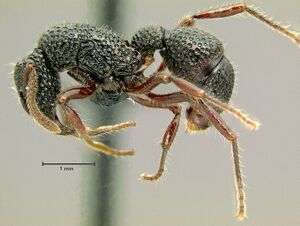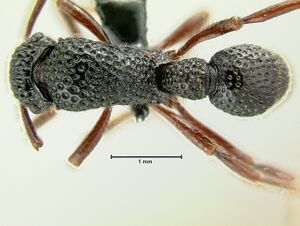Stictoponera posteropsis
| Stictoponera posteropsis | |
|---|---|

| |
| Scientific classification | |
| Kingdom: | Animalia |
| Phylum: | Arthropoda |
| Class: | Insecta |
| Order: | Hymenoptera |
| Family: | Formicidae |
| Subfamily: | Ectatomminae |
| Tribe: | Ectatommini |
| Genus: | Stictoponera |
| Species: | S. posteropsis |
| Binomial name | |
| Stictoponera posteropsis Gregg, 1951 | |
Labels from some of the specimens examined indicated that some came from leaf-mold berlesate and rainforest or were taken while foraging on vegetation.
Identification
Lattke (2004) - This striking species cannot be mistaken for any other Stictoponera. The posteriorly placed eyes, the keel on the gaster, and the deep transverse sulcus on the anterior margin of the fourth abdominal sternite suggest specialized predatory habits.
Distribution
Known from Borneo, Malaysia, Philippines and Sumatra.
Latitudinal Distribution Pattern
Latitudinal Range: 14.66666667° to -7.1315°.
| North Temperate |
North Subtropical |
Tropical | South Subtropical |
South Temperate |
- Source: AntMaps
Distribution based on Regional Taxon Lists
Indo-Australian Region: Borneo, Indonesia (type locality), Malaysia, Philippines, Singapore.
Distribution based on AntMaps
Distribution based on AntWeb specimens
Check data from AntWeb
Countries Occupied
| Number of countries occupied by this species based on AntWiki Regional Taxon Lists. In general, fewer countries occupied indicates a narrower range, while more countries indicates a more widespread species. |

|
Estimated Abundance
| Relative abundance based on number of AntMaps records per species (this species within the purple bar). Fewer records (to the left) indicates a less abundant/encountered species while more records (to the right) indicates more abundant/encountered species. |

|
Biology
Castes
Male is unknown.
Worker
  
| |
| . | Owned by Museum of Comparative Zoology. |
Nomenclature
The following information is derived from Barry Bolton's Online Catalogue of the Ants of the World.
- posteropsis. Stictoponera posteropsis Gregg, R.E. 1951: 77, figs. 1, 3A,C (q.) INDONESIA (Sumatra).
- Type-material: holotype queen.
- Type-locality: Indonesia: Sumatra, Lampong Prov., Wai Lima, 12.xi.1921 (H.H. Karny).
- Type-depository: MCZC.
- Lattke, 2004: 146 (w.).
- Combination in Gnamptogenys: Brown, 1958g: 229;
- combination in Stictoponera: Camacho, Franco, Branstetter, et al. 2022: 12.
- Status as species: Brown, 1954h: 7; Brown, 1958g: 229; Baltazar, 1966: 236; Bolton, 1995b: 210; Lattke, 2004: 146 (redescription); Pfeiffer, et al. 2011: 35; Camacho, Franco, Branstetter, et al. 2022: 12.
- Distribution: Indonesia (Sumatra), Malaysia (Peninsula, Sabah, Sarawak), Philippines (Luzon, Negros).
Unless otherwise noted the text for the remainder of this section is reported from the publication that includes the original description.
Lattke (2004) - Eye subglobulose and situated one-half its diameter or less from the vertex in lateral view; postpetiolar sternum with V-shaped anterior process and longitudinal median keel extending from process to just beyond posterior sternal margin, forming angular lamellate projection.
Description
Worker
Lattke (2004) - Metrics. (n = 3): HL 1.09-1.74, HW 0.92-1.35, ML 0.54-0.90, SL 0.89-1.51, ED 0.17-0.26, WL 1.53-2.49 mm. CI 0.78-0.88, SI 0.97-1.12, MI 0.59-0.67, OI 0.19-0.20. Head with straight lateral margins in frontal view, posterior margin concave with posterolateral projecting occipital lobes, anterior margin of clypeal lamella slightly sinuate with convex median projection; clypeus usually longitudinally strigulose with shallow median sulcus, occasionally transversely strigulose or mostly smooth with scattered punctae; frons mostly with round to oval foveolae; vertex posteriorly bordered by transverse carina that joins occipital lobes; eye situated one-half its diameter or less from vertex; scape longitudinally strigulose; mandibular dorsum mostly longitudinally strigose with scattered prominent costae, masticatory margin slightly denticulate; occipital lobe projects posteroventrad in lateral view.
Mesosomal dorsum with uniformly distributed round to oval foveolae, intervening cuticle smooth; humeral angle lamellate; promesonotal suture weakly impressed, discernible only medially; anepisternum relatively narrow; metanotal sulcus vaguely impressed; mesosoma with very broadly convex dorsal margin in lateral view, mostly foveolate, especially propodeum; propodeal declivity bordered by triangular lamella that surrounds declivity, declivity mostly smooth except for median raised area. Petiolar dorsum densely foveolate, ventral process subquadrate in lateral view; postpetiolar dorsum with round to slightly oval foveolae, not as dense as on mesonotum, posterior margin scrobiculate; sternum with V-shaped anterior process and longitudinal median keel extending from process to just beyond posterior sternal margin, keel occasionally medially effaced, posteriorly forming angular projection; dorsum of abdominal segment 4 longitudinally costate, laterally foveolate; presternite of fourth abdominal sternite with bluntly pointed posteromedian directed lobe that hangs over broad, deep transverse sulcus with smooth cuticle on 3/4 anterior part of sternite, posterior fourth longitudinally strigulose; presternal lobe hook shaped in lateral view. Fore coxa strigose laterally; fore tarsus opposite strigil with row of setae, basal seta stoutest. Dorsum of thorax and abdominal segments 1-4 with abundant erect hairs. Head, mesosoma, petiole, and gaster reddish to dark brown; mandibles, antennae, legs light brown to brown.
Queen
Lattke (2004) - Metrics (n = 1): HL 1.80, HW 1.42, ML 0.87, SL 1.52, ED 0.32, WL 2.73 mm. CI 0.79, SI 1.07, MI 0.61, OI 0.23. Pronotum densely foveolate laterally, medially either foveolate or mostly smooth; mesonotum longitudinally rugulose-punctate; anepisternum foveolate to longitudinally rugulose with scattered foveolae; propodeum densely foveolate.
Type Material
Lattke (2004) - Holotype queen: [Indonesia], Sumatra, Lampong, Wai Lima (Karny) (Museum of Comparative Zoology) [Examined].
References
- Brown, W. L., Jr. 1958g. Contributions toward a reclassification of the Formicidae. II. Tribe Ectatommini (Hymenoptera). Bulletin of the Museum of Comparative Zoology 118: 173-362 (page 229, Combination in Gnamptogenys)
- Camacho, G.P., Franco, W., Branstetter, M.G., Pie, M.R., Longino, J.T., Schultz, T.R., Feitosa, R.M. 2022. UCE phylogenomics resolves major relationships among Ectaheteromorph ants (Hymenoptera: Formicidae: Ectatomminae, Heteroponerinae): A new classification for the subfamilies and the description of a new genus. Insect Systematics and Diversity 6(1): 5; 1–20 (doi:10.1093/isd/ixab026).
- Gregg, R. E. 1951. Two new species of exotic ants. Psyche (Camb.) 58: 77-84. (page 77, figs. 1, 3 queen described)
- Lattke, J. E. 2004. A Taxonomic Revision and Phylogenetic Analysis of the Ant Genus Gnamptogenys Roger in Southeast Asia and Australasia (Hymenoptera: Formicidae: Ponerinae). University of California Publications in Entomology 122: 1-266 (page 146, fig. 34 worker, queen described)
- Wang, W.Y., Soh, E.J.Y., Yong, G.W.J., Wong, M.K.L., Benoit Guénard, Economo, E.P., Yamane, S. 2022. Remarkable diversity in a little red dot: a comprehensive checklist of known ant species in Singapore (Hymenoptera: Formicidae) with notes on ecology and taxonomy. Asian Myrmecology 15: e015006 (doi:10.20362/am.015006).
- Yamane, S., Tanaka, H.O., Hasimoto, Y., Ohashi, M., Meleng, P., Itioka, T. 2021. A list of ants from Lambir Hills National Park and its vicinity, with their biological information: Part II. Subfamilies Leptanillinae, Proceratiinae, Amblyoponinae, Ponerinae, Dorylinae, Dolichoderinae, Ectatomminae and Formicinae. Contributions from the Biological Laboratory, Kyoto University 31, 87–157.
References based on Global Ant Biodiversity Informatics
- Brown W. L., Jr. 1954. A review of the coxalis group of the ant genus Stictoponera Mayr. Breviora 34: 1-10.
- Brown W. L., Jr. 1958. Contributions toward a reclassification of the Formicidae. II. Tribe Ectatommini (Hymenoptera). Bulletin of the Museum of Comparative Zoology 118: 173-362.
- Gregg R. E. 1951. Two new species of exotic ants. Psyche (Cambridge) 58: 77-84.
- Lattke J. E. 2004. A taxonomic revision and phylogenetic analysis of the ant genus Gnamptogenys Roger in Southeast Asia and Australasia (Hymenoptera: Formicidae: Ponerinae). University of California Publications in Entomology 122: 1-266.
- Lattke, J.E. 2004. A taxonomic revision and phylogenetic analysis of the ant Gnamptogenys Roger in Southeast Asia and Australasia (Hymenoptera: Formicidae: Ponerinae). University of California Publications in Entomology 122: 1-266
- Pfeiffer M., and D. Mezger. 2012. Biodiversity Assessment in Incomplete Inventories: Leaf Litter Ant Communities in Several Types of Bornean Rain Forest. PLoS ONE 7(7): e40729. doi:10.1371/journal.pone.0040735
- Pfeiffer M., and D. Mezger. 2012. Biodiversity Assessment in Incomplete Inventories: Leaf Litter Ant Communities in Several Types of Bornean Rain Forest. PLoS ONE 7(7): e40729. doi:10.1371/journal.pone.0040847
- Pfeiffer M., and D. Mezger. 2012. Biodiversity Assessment in Incomplete Inventories: Leaf Litter Ant Communities in Several Types of Bornean Rain Forest. PLoS ONE 7(7): e40729. doi:10.1371/journal.pone.0040973
- Pfeiffer M.; Mezger, D.; Hosoishi, S.; Bakhtiar, E. Y.; Kohout, R. J. 2011. The Formicidae of Borneo (Insecta: Hymenoptera): a preliminary species list. Asian Myrmecology 4:9-58
- Woodcock P., D. P. Edwards, R. J. Newton, C. Vun Khen, S. H. Bottrell, and K. C. Hamer. 2013. Impacts of Intensive Logging on the Trophic Organisation of Ant Communities in a Biodiversity Hotspot. PLoS ONE 8(4): e60756. doi:10.1371/journal.pone.0060756
- Woodcock P., D. P. Edwards, T. M. Fayle, R. J. Newton, C. Vun Khen, S. H. Bottrell, and K. C. Hamer. 2011. The conservation value of South East Asia's highly degraded forests: evidence from leaf-litter ants. Phil. Trans. R. Soc. B. 366: 3256-3264.


